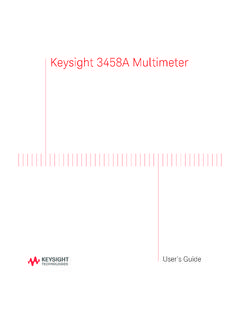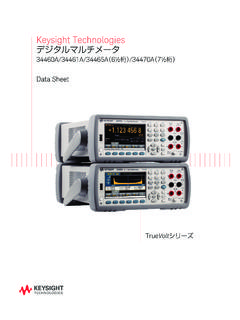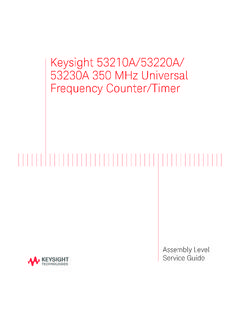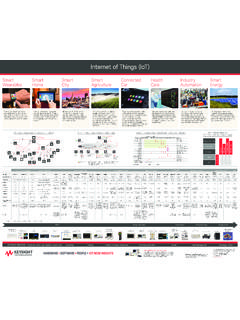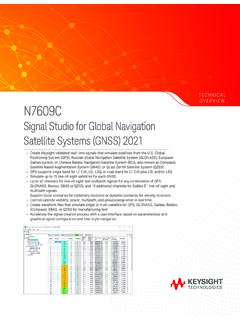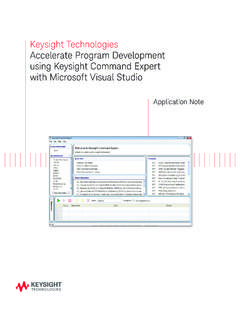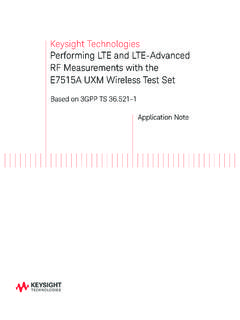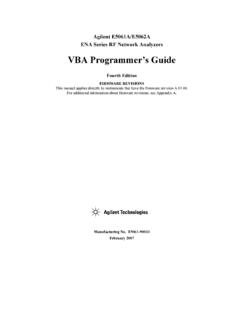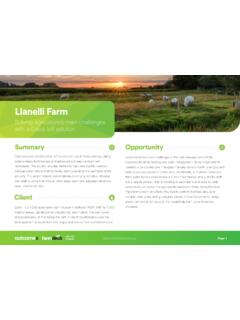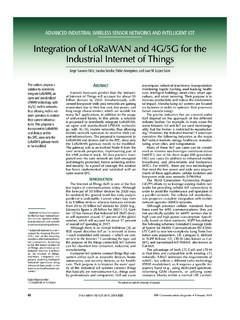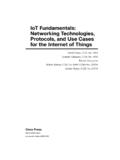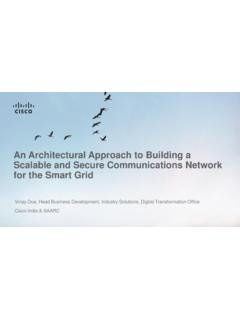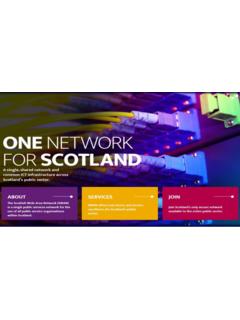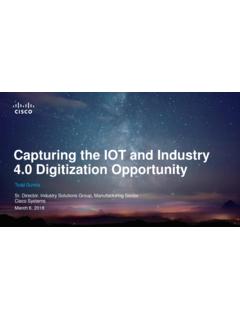Transcription of Keysight Technologies A Little dB’ll Do Ya!
1 The rapid growth of the Internet of Things (IoT) is driving growth and innovation in low power wide area network (LPWAN) Technologies . The wide variety of radio Technologies gives IoT solution providers a choice of communication protocols, but that choice can be very complex, with many tradeoffs and confusing details to application brief will summarize the key factors, with a focus on data transmission range, link budget, and data TechnologiesA Little dB ll Do Ya!A Survey of Low Power Wide Area Network (LPWAN) RF Technologie sApplication Brief02 | Keysight | A Little dB ll Do Ya! - Application BriefTechnology OverviewsIngenuIngenu is a company based in San Diego, California whose LPWAN solution is based on their proprietary RPMA (Random Phase Multiple Access) technology. It uses the ISM band worldwide, and Ingenu claims that RPMA is specifically designed to support to billions or tens of billions of , which stands for Long Range Wide Area Network, is a specification for battery-powered, wireless IoT devices that uses a chirped spread spectrum (CSS) technology developed by Semtech.
2 The upper-layer protocol specification is produced and supported by the LoRa Alliance, which includes companies such as cisco , IBM, and Renesas, but the protocols for the lower levels are proprietary to Semtech. A lorawan network operates in sub-GHz bands and is typically configured in a star of stars topology, with IoT devices communicating bidirectionally to gateways that are connected to a back-end rates range from 300 bps to 50 kbps, and the lorawan network server manages the speed tradeoffs between the battery life of the end devices and the overall capacity of the network. Because of the way the LoRa protocol modulates data and corrects for errors, a lorawan signal can actually transmit data at sub-noise floor signal strengths and resist interference. lorawan uses three layers of keyed Cat-M1 LTE Cat-M1, which is defined by the 3 GPP enhanced machine-type communications (eMTC) standard, is one of two User Equipment (UE) categories in the LTE IoT family. Both LTE IoT UE categories are designed for IoT-centric traffic, including: Low cost devices Low-power nodes that need long battery life Large numbers of devicesEquipment supporting the LTE Cat-M1 standard delivers data rates up to 1 Mbps (upload and download) while coexisting with traffic in existing LTE FDD/TDD spectrum.
3 LTE Cat-M1 also supports Voice over LTE (VoLTE) and includes an enhanced coverage mode that adds 15 dB of link budget for further signal penetration inside buildings. LTE Cat-M1 uses MHz of bandwidth and leverages legacy LTE synchronization signals such as PSS7 and SSS8. LTE Cat-M1 also supports network-initiated handovers; it can move from one cell to another in milliseconds when requested by the Cat-NB1 (NB-IoT)LTE Cat-NB1, also known as NarrowBand IoT (NB-IoT) is another UE category in the LTE IoT family. It is much slower than LTE Cat-M1, with download and upload speeds of roughly 200 kbps as of Release 13, but it requires less than 200 kHz of spectrum bandwidth. NB IoT can support up to 200,000 devices per cellular cell, and because it uses the 3 GPP licensed cellular network spectrum, it has substantial protection against interference. Unlike LTE Cat-M1, Cat-NB1 does not support active cell-to-cell handover, so it is less suitable for maintaining data continuity in some mobile applications.
4 However, LTE Cat-NB1 does support UE-initiated cell link budget of NB-IoT is a few dB better than LTE Cat-M1. NB-IoT can also be deployed in refarmed GSM spectrum or multiplexed with LTE carriers in LTE bands. Both LTE Cat-M1 and NB-IoT will be deployed worldwide with software updates to existing infrastructure. The use of licensed spectrum and existing dense infrastructure means that the capacity, coverage, and in-building penetration of NB-IoT will be excellent, comparing very favorably with other LPWAN | Keysight | A Little dB ll Do Ya! - Application BriefLong range WiFiSome equipment suppliers provide long range links using unlicensed WiFi frequencies and radios combined with larger antennas driven by Power over Ethernet (PoE). These support point-to-point and point-to-multipoint configurations, and distances over 250 km have been achieved by specialists working in relatively remote areas. Because long range WiFi exists in an unlicensed part of the electromagnetic spectrum, it is subject to interference, and the power requirement is too high for many IoT end devices.
5 In some IoT applications, such as large-scale smart agriculture or outdoor recreation in remote areas, it may be a good solution to pair a backhaul radio with a local access point to support a cluster of WiFi-enabled IoT is a proprietary RF connectivity service for the IoT from the French company SIGFOX. It is an inexpensive, low-power solution for connectivity from sensor to cloud, based on a centrally regulated ecosystem of partner organizations and solution providers. Sigfox also supports Sigfox Spot it, an optional, low-energy location service for Sigfox modules that does not rely on uses a subscription-based business model, and it is particularly prevalent in Europe. The technology uses tower-mounted base stations, and its ultra-narrow band (UNB) RF technology is based on binary phase-shift keyed (BPSK) transmissions in sub-GHz bands. Because it uses UNB, Sigfox transmissions tend to be well above the noise floor in any given spectral region, and it is particularly well suited for slow uploads (300 bps or less) of very small data is a UK-headquartered company that provides a proprietary, fully bidirectional, ultra-narrowband (UNB) LPWAN solution for smart city applications, such as smart parking, smart lighting, and tracking.
6 Telensa operates in sub-GHz bands worldwide. Telensa provides solutions in some smart city vertical markets, and a smart city API that enables partner organizations to support other IoTWAVIoT is a full-duplex LPWAN technology for machine-to-machine (M2M) telemetry and IoT applications, based on a proprietary Narrowband Fidelity (Nb-Fi) protocol. The WAVIoT company began in 2011, and the WAVIoT technology relies on full duplex gateways based on bidirectional SDR principles using three 120-degree antennas. According to the company, WAVIoT supports: More than two million nodes per gateway A link budget that could be as large as 194 dB Effective distances of over 50 km (rural) and 10-15 km (urban)Weightless-NWeightless-N is an open LPWAN standard from the Weightless Special Interest Group (Weightless SIG). Weightless-N uses sub-GHz ultra-narrow band (UNB) technology in a star topology. The Weightless SIG claims ranges of several kilometers in urban environments. Weightless-N uses a differential binary phase shift keying (DBPSK) digital modulation scheme and a frequency hopping algorithm to mitigate interference.
7 It uses a shared secret key algorithm for implicit authentication and encrypts data via a 128-bit AES algorithm. The technology supports mobile applications and co-located, multi-vendor | Keysight | A Little dB ll Do Ya! - Application BriefWireless M-BusWireless M-Bus is a specification defined under EN 13757-4 for RF communication between utility meters (water, gas, electric, and so on) and data aggregation devices. It operates in three sub-GHz bands and is often used in European smart metering and Advanced Metering Infrastructure (AMI) applications. Wireless M-Bus uses a star topology and does not support either IP or mesh networks. Therefore, its software stack is both small and relatively simple to to ConsiderWhen you compare various LPWAN Technologies , there are several factors to consider. These include: Data transfer speed Costs Industry support Power consumptionData transfer speedIt is relatively easy to find maximum data transfer rates for various LPWAN Technologies , but there is more to the story.
8 Different Technologies support different packet sizes, and they also have different levels of protocol overhead. The interplay among these factors determines the actual goodput (rate of useful data transmission) of the network. Therefore, when you select an RF format, consider how frequently your endpoint device must communicate with the base station, how much data must be transferred, and how much battery life you are willing to spend on each are several costs that you need to consider when selecting an LPWAN technology. The hardware costs are the most obvious, but they may turn out to be a relatively small part of the overall picture. You must also consider installation costs, network administration costs, security costs, data transfer costs, and subscription costs. You must also consider the costs of evolving your LPWAN solution over time. Be careful to account for ongoing costs and for risks and hidden costs that go well beyond the price tag on the purchase order for the supportToday s inexpensive solution may turn out to be very expensive if support for it declines in the future, or if your needs expand beyond the solution s capability, either technologically or geographically.
9 Therefore, you must consider the overall level of industry support for various LPWAN Technologies , including base station availability, the number of hardware vendors supporting the standard, and the number of backhaul vendors supporting the standard. You should also consider the standard itself; is it open or proprietary? Is security built-in or left to the user? What portion of the spectrum does it use, and how crowded is that spectrum? To what degree is the standard supported by existing communications infrastructure, and to what degree is the standard likely to be supported and kept current as Technologies and applications evolve? Effective distances Cybersecurity Software stability05 | Keysight | A Little dB ll Do Ya! - Application BriefDistance and data rateMany IoT applications operate in relatively remote areas, using low-power, battery powered devices. In such situations, you must also consider current consumption, effective transmission ranges, and link budgets, as summarized in the table below.
10 All figures are approximate and may vary based on the application and the RF LPWAN marketplace is complex and evolving quickly. As a key enabler of the IoT, it is a source of great opportunity, but you must be very careful in balancing the various costs and benefits to ensure a profitable solution over a long period of Budget (dB)RangeMax Data Rate (kbps)Ingenu168 to 17213 km41 LoRaWAN150 to 16815 km5 LTE Cat-M115 610 km1000 LTE Cat-NB116 410 km200 Sigfox14 6 -16 250 ~16 02 km0 .1 Wireless M-Bus1301 | Keysight | A Little dB ll Do Ya! - Application BriefThis information is subject to change without notice. Keysight Technologies , 2017 Published in USA, December 1, more information on Keysight Technologies products, applications or services, please contact your local Keysight office. The complete list is available Canada(877) 894 4414 Brazil55 11 3351 7010 Mexico001 800 254 2440 United States(800) 829 4444 Asia PacificAustralia1 800 629 485 China800 810 0189 Hong Kong800 938 693 India1 800 11 2626 Japan0120 (421) 345 Korea080 769 0800 Malaysia1 800 888 848 Singapore1 800 375 8100 Taiwan0800 047 866 Other AP Countries(65) 6375 8100 Europe & Middle EastAustria0800 001122 Belgium0800 58580 Finland0800 523252 France0805 980333 Germany0800 6270999 Ireland1800 832700 Israel1 809 343051 Italy800 599100 Luxembourg+32 800 58580 Netherlands0800 0233200 Russia8800 5009286 Spain800 000154 Sweden0200 882255 Switzerland0800 805353 Opt.

